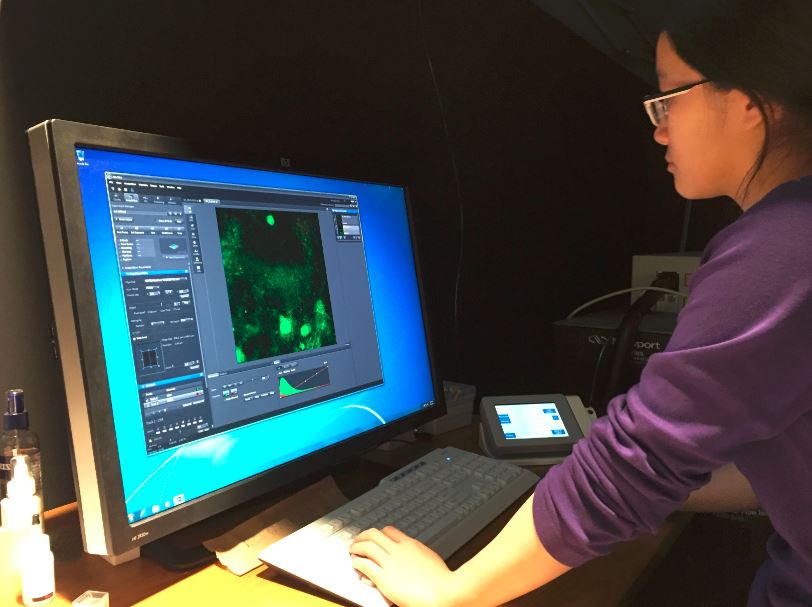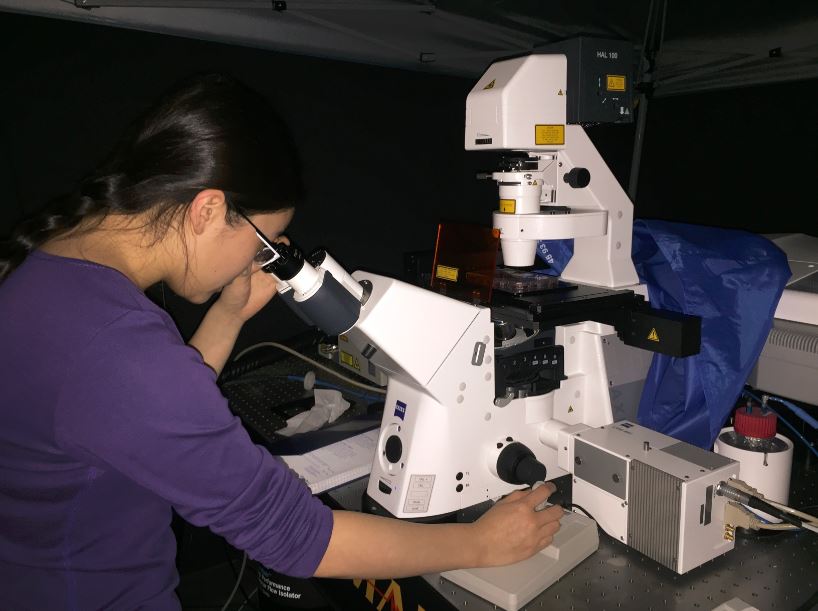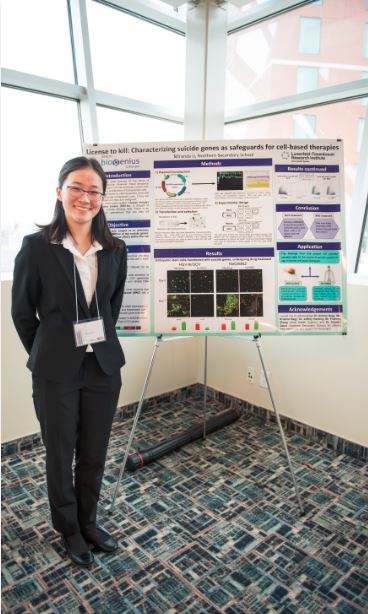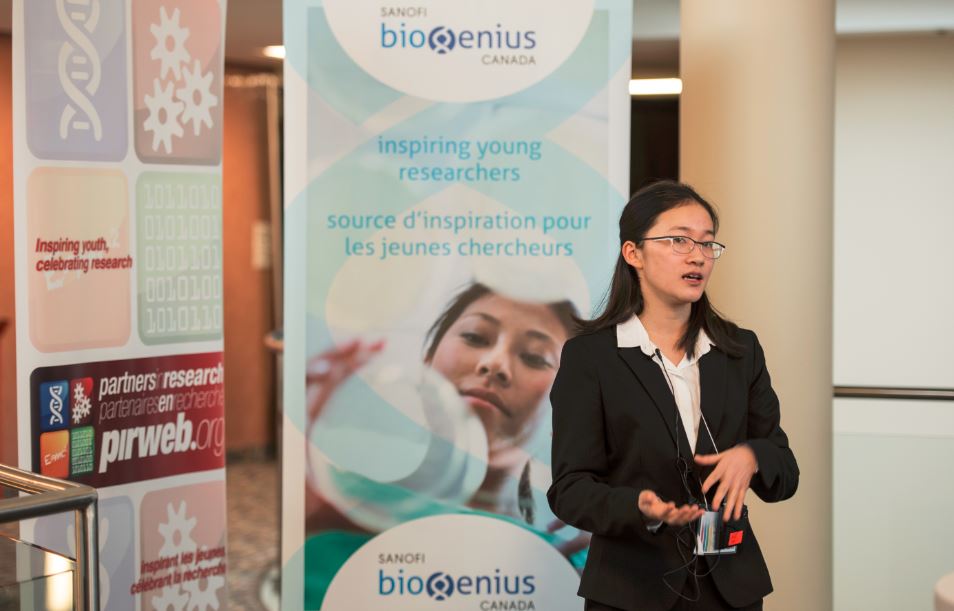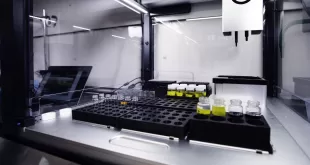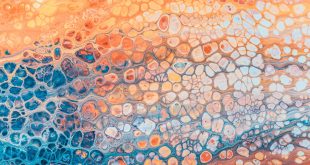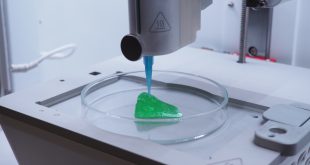By Hermione Wilson
Miranda Li is not your typical 17-year-old. She holds a black belt in taekwondo, swims competitively and has a passion for stem cell research. In 2015, that passion led her to the Nagy Lab at the Lunenfeld-Tanenbaum Research Institute in Toronto, where she worked on an innovative project about characterizing suicide genes.
The Mentorship
It began with the Sanofi Biogenius Canada (SBC) competition, in which Li wanted to participate. The competition, which began in Toronto in 1992, is open to all students registered in high school. “The goal is to highlight excellent youth science research that’s going on in the field of biotechnology,” says Brent Peltola, Executive Director of Partners in Research Canada, which has been a managing partner of the SBC competition since 2013.
SBC starts with nine regional competitions where all the candidates do a poster presentation and oral presentation to a panel of judges who are drawn from industry and research in the field of biotechnology. Of the top five winners awarded at the regional level and each of the first place winners attends the national competition. A key component of entering the competition is securing a mentorship at a local laboratory, Peltola says. Most students do this before they send in their applications for the competition.
With that in mind, when Li had the opportunity to attend the prestigious Gairdner Awards (often a precursor to the Nobel Prize) in 2015, she made sure to introduce herself to Kristina Nagy, a research associate at the Nagy Lab and the wife of the lab’s principal investigator Dr. Andras Nagy. Li knew that the Nagy Lab performs work in stem cells, an area which was of particular interest to her.
“She had been reading up on what our lab had been doing,” Nagy says of that first meeting. “I was very impressed by her… having such initiative.” Nagy agreed to take Li on at the lab and the then 16-year-old started working at the end of October 2015.
The Project
Nagy Lab’s main focus is stem cells and their applications to regenerative medicine. “We are trying to figure out ways to use stem cells to transplant them into patients that are suffering from diseases that are currently not possible to really cure,” Nagy says. The project Nagy designed for Li would require the high school student to develop a tool that could assess whether different drugs caused stem cells that have been transplanted into patients to proliferate or not.
“[When] you transplant cells into the individual… there’s always a risk that those cells are going to become malignant, meaning they’re going to give you cancer, and the last thing you want is to cure a disease and give a patient cancer,” Nagy says. A way to solve that problem, she says, is to introduce a system into the cells before they are put into the patient whereby, if a certain drug which is not harmful to the patient by to which the cells are sensitive is introduced into the patient’s system, it will kill those cells. This system is known as a suicide gene system.
Depending on the application, some suicide gene systems are more effective than others, Nagy says. The most commonly used suicide gene system only kills cells that are proliferating, but there is a new system which Nagy says also kills cells that are not proliferating. Li’s task was to figure out what this was and at what stage in the cell cycle the drug was killing them.
The tool Li came up with to track the cells and their reaction to the suicide gene prodrug involved fluorescent proteins. The proteins can be produced by a cell and will light up with different colours under UV light. Using what Li calls the FUCCI (Fluoresence Ubiquitin Cell Cycle Indicator) System, a method of visualizing cell cycle behaviour that involves transecting extracts from corals and plants into the cells, the high school student was able to track cells as they progressed through the cell cycle and then observe how they reacted when she added the prodrug that triggered the suicide genes.
“A cell that is in one stage of the cell cycle will be green, and as it goes into other stage of the cell cycle and starts to proliferate, it turns red,” Nagy explains. This imaging technique allowed Li to see whether there were more green cells or more red cells dividing, or if each progressed at the same rate before and after the prodrug was added to the cells.
“That information is very important to us in the long run because now we know how that suicide gene really works,” Nagy says.
Lab Work
During the eight months Li spent working at Nagy Lab, she got a crash course in research science at a very high level. Her typical day at the lab began after a day of classes and a 40-minute walk from her high school to the Lunenfeld-Tanenbaum Research Institute, located near Toronto’s Mount Sinai Hospital.
“Depending on what stage of the project I was in, I would either work for half an hour and then go home and do homework, or there were days where I’d be at the lab until nine at night,” Li says.
With Nagy guiding her every step of the way, Li did a lot of molecular cloning, imaging and cell culture. She put together the cells she worked with, cloning together colour changing genes and suicide genes.
“[Miranda] did a lot of cloning and she used plasma DNA in bacteria to amplify that,” Nagy says. “She did PCR reactions, she had to go and send bits and pieces of DNA for sequencing and check that the sequence was actually correct, the one we were expecting to get. Then she had to transect these cells, meaning putting the DNA into these cells, and culture those cells.”
Once the cell culture grew to larger quantities, Li had to split them into several dishes, freezing some to cryopreserve them, until she had to warm them up again. She also did a lot of imaging. The high school student was able to use one of the Lunenfeld Tanenbaum Research Institute’s most expensive and sophisticated microscopes, a two-photon laser-scanning confocal microscope valued at half a million dollars.
“That one’s really cool,” Li says. “That one had a special room that was downstairs and you needed a pass to get in and everything. With light microscope you can’t really tell the different colours, but with the confocal [microscope] we use different filters like fluorescent filters, so you could tell which cells were dividing.”
Analyzing the resulting images was another skill set Li had to develop, as well as understanding the complex software used to do that analysis.
“It was a steep learning curve for her, for sure, but she turned out to be very talented,” Nagy says. Li spent the first few weeks of her placement reading up on the work she would have to do, but Nagy says she caught on faster than some undergraduate and postgraduate students she works with.
It was by no means smooth sailing, however. Li says she experienced firsthand just how difficult research science is. “Whenever you read about something that a scientist did you think, ‘OK, that sounds pretty straightforward,’” she says. “They had this hypothesis, they went through these steps and they got to the results.” She soon discovered things weren’t so straightforward. During the course of her project, Li says there were a lot of trials and failures, and she found herself rushing to finish in time for nationals, after she won first prize at the Toronto regional level in April 2016.
Although she didn’t place at the national SBC competition, Li’s experience at Nagy Lab has definitely left its mark. She is seriously considering a career in research science and says she learned more in her eight months at the lab than she ever did in her four years of high school.
“Even though I was taking biology and chemistry at the same time in school, the information that you might learn from the lab is so much more than what you would learn from the textbook,” Li says.
After the SBC competition was over, Li returned to Nagy Lab in the summer of 2016, this time under the mentorship of Dr. Mohammad Massumi. “He has these cells that produce insulin, so it was a very different project but I used a lot of the same skills and techniques I picked up [working at the lab] during the school year,” Li says. “We were trying to make a cell line that could… produce an unlimited supply of insulin for diabetes [patients].”
Nagy says having Li as a student lab assistant was a wonderful experience, one she says the lab would consider repeating. “I think it is really important for scientists to… go out and be much more transparent and let people in as much as possible in the lab, especially young people.”
 BioLab Business Magazine Together, we reach farther into the Canadian Science community
BioLab Business Magazine Together, we reach farther into the Canadian Science community
